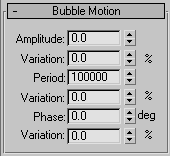Bubble motion provides the wobbling effect you see in bubbles rising underwater. Typically, it's used when the particles are set to rise in thin streams. Bubble motion is similar to a waveform, and the Bubble Motion parameters let you adjust the amplitude, period, and phase of the bubble "wave."
Note: The bubble motion is not affected by space warps, so you can use a space warp to control the direction of the particle flow without altering the local, wobbling bubble effect.
Tip: InterParticle Collisions, Deflector Binding, and Bubble Noise do not get along well together. Particles may leak through the deflector when these three are used together. Instead of bubble motion, use animated mapping. Use facing particles with an animated map of a bubble, where the bubble is smaller than the map size. The bubble is animated moving around the map. This simulates bubble motion at the map level.
Interface

- Amplitude
-
The distance the particle moves off its usual velocity vector as it travels.
- Variation
-
The percent of Amplitude variation applied to each particle.
- Period
-
The cycle time for one complete oscillation of a particle through the bubble "wave." A recommended value might be 20 to 30 intervals.
Note: Bubble motion is measured in time, not in rate, so a very large Period value means the motion takes a long time to complete. Thus, there is no motion, effectively. Period is therefore set to a very large default value so that the default motion of this type is none. - Variation
-
The percent of Period variation for each particle.
- Phase
-
The initial displacement of the bubble pattern along the vector.
- Variation
-
The percent of Phase variation for each particle.